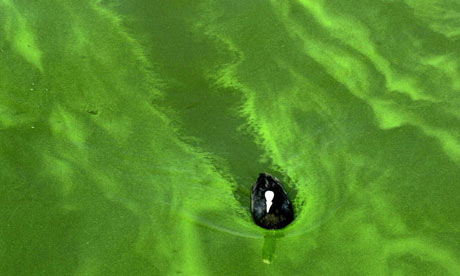A combination of mild weather and high levels of phosphate nutrients from agriculture and homes are to blame for the green, porridge-like toxic algae blooms that have blighted British canals and lakes this summer, the Environment Agency has said.
There have been 83 algal incidents so far this year – a month into the three-month algae season – a higher than usual amount, according to the agency. In 2010, the number of incidents reached 225, while the peak year was 2005, when 226 were reported.
It is not yet clear how many of this year's incidents are blue-green algae. Blue-green algae (Cyanobacteria) are natural inhabitants of many inland waters and estuaries, and form potentially toxic green scum when they die.
These toxin-producing blooms, called harmful algal blooms, have been known to kill wild animals, livestock and pets, and can be harmful to people.
Toxic algae have been detected in high concentrations in Loch Coulter, near Stirling, the Llys y Fran reservoir, in south-west Wales, Malthouse and Ranworth Broads in Norfolk, the Serpentine, in London and the Wishing Tree reservoir, in East Sussex.
Other areas have also suffered excessive amounts of algal blooms, with water activities suspended as British Waterways officials were forced to take action.
The blooms are caused by a surge in algae brought on by a combination of climatic factors including the recent calm, mild weather, drought in some parts of the UK causing slow-moving water, and July's heavy rain in other parts of the country, which increased the amount of nutrients from fertilisers, sewage and detergents in the waterways.
In humans who have swallowed or swum through the blooms, toxins have been linked to neurological, digestive and skin problems and long-term liver disease.
In 1989, two soldiers taking part in canoe training at the algae-hit Rudyard Lake, in Staffordshire, became severely ill with atypical pneumonia. Others reported abdominal pains, vomiting, diarrhoea, blistering of the mouth and sore throats.
Algal toxins have also been major contributors to fish kills. Professor Geoffrey Codd, of Dundee and Stirling Universities, who is a leading expert on blue-green algae, said: "It's possible that those toxins can accumulate in the fish."
Blue-green algae feed off nitrates from the air and phosphates from the water. The Plantlife Wales conservation officer, Ray Woods, said: "When extra phosphates enter the water in sewage and fertilisers, the algae thrive. With nitrogen from the air and the higher phosphate levels, the blue-green algae just keep growing and can become excessive."
Because it is difficult to determine whether blue-green algae blooms and scums are toxic – although the vast majority are – local authorities presume any algal scum is potentially toxic, and it is treated accordingly.
A comprehensive monitoring programme has been developed in conjunction with Codd, who is working to develop methods to test for the toxins and to develop policies to protect animals and humans.
"It's an international effort. We do have capability to manage these problems. In the UK, there are nationwide systems for monitoring and reporting algal blooms," he said. "The scum on the surface of the water should serve to remind us of the potential economic and health problems that the algae can pose."
The Environment Agency has advised members of the public to use less detergent in dishwashers and washing machines, but Woods said more needed to be done to control the problem.
"The water industry has been using phosphate stripper but, with our changing climate, we will have to place greater controls on phosphate use," he added. "Farmers will have to use fertilisers with more care. The world's phosphate resources are limited, and this is a growing issue."
Codd, speaking from a blue-green algae and public health conference in Maine, US, said: "The negative impacts of algae are very serious in the US, with a lot of lakeside facilities being badly affected.
"These organisms can massively develop to present considerable economic problems, with tourism affected and increased costs to water industry. It's an international problem which is attracting attention of public health officials."










